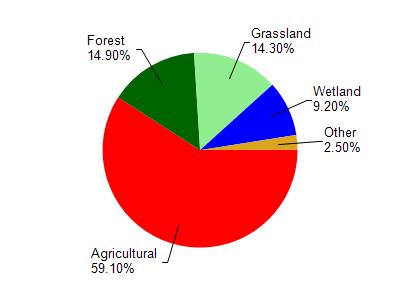
10.45 Miles
0 - 10.45
Macroinvertebrate, Cool-Cold Headwater
2015
Poor
Impairment Unknown
Total Phosphorus
Marathon
No
No
Yes
Fish and Aquatic Life
Overview
Hamann Creek is classified as a warm water forage fishery. Water chemistry samples taken in the mid- to late '70s during run-off had suspended solids concentration up to 1,000 parts per million (ppm), phosphorous values up to 1.0 ppm and organic concentrations increased about four-fold. Thick growths of filamentous algae are common, indicating a nutrient problem. Run-off and streambank pasturing are sources of nutrients entering the stream. The forage fishery could improve if nutrient sources were reduced or eliminated.
Kreitlow, James D. 1991. Upper Wisconsin River Central Sub-Basin Water Quality Management Plan. PUBL-WR-287-91-REV. Wisconsin Department of Natural Resources, Madison, WI.
Date 1991
Author Aquatic Biologist
Impaired Waters
Hamann Creek (1429900) was placed on the impaired waters list in 2014 for total phosphorus. The 2016 assessments showed continued impairment by phosphorus; total phosphorus sample data exceeded 2016 WisCALM listing criteria for the Fish and Aquatic Life use, however, available biological data did not indicate impairment (i.e. no macroinvertebrate or fish Index of Biotic Integrity (IBI) scored in the "poor" condition category). Based on the most updated information, no change in existing impaired waters listing is needed.
Date 2015
Author Aaron Larson
Condition
Wisconsin has over 84,000 miles of streams, 15,000 lakes and milllions of acres of wetlands. Assessing the condition of this vast amount of water is challenging. The state's water monitoring program uses a media-based, cross-program approach to analyze water condition. An updated monitoring strategy (2015-2020) is now available. Compliance with Clean Water Act fishable, swimmable standards are located in the Executive Summary of Water Condition in 2018. See also the 'monitoring and projects' tab.
Reports
Management Goals
Wisconsin's Water Quality Standards provide qualitative and quantitative goals for waters that are protective of Fishable, Swimmable conditions [Learn more]. Waters that do not meet water quality standards are considered impaired and restoration actions are planned and carried out until the water is once again fishable and swimmable
Management goals can include creation or implementation of a Total Maximum Daily Load analysis, a Nine Key Element Plan, or other restoration work, education and outreach and more. If specific recommendations exist for this water, they will be displayed below online.
Monitoring
Monitoring the condition of a river, stream, or lake includes gathering physical, chemical, biological, and habitat data. Comprehensive studies often gather all these parameters in great detail, while lighter assessment events will involve sampling physical, chemical and biological data such as macroinvertebrates. Aquatic macroinvertebrates and fish communities integrate watershed or catchment condition, providing great insight into overall ecosystem health. Chemical and habitat parameters tell researchers more about human induced problems including contaminated runoff, point source dischargers, or habitat issues that foster or limit the potential of aquatic communities to thrive in a given area. Wisconsin's Water Monitoring Strategy was recenty updated.
Grants and Management Projects
Monitoring Projects
| WBIC | Official Waterbody Name | Station ID | Station Name | Earliest Fieldwork Date | Latest Fieldwork Date | View Station | View Data |
|---|
| 1429900 | Hamann Creek | 373141 | Hamann Creek at Huckleberry Rd | | | Map | Data |
| 1429900 | Hamann Creek | 373322 | Hamann Creek at Cth N Bridge | 3/25/1976 | 7/20/1976 | Map | Data |
| 1429900 | Hamann Creek | 373324 | Hamann Creek at Twn Rd Sec 2+11 | 3/25/1976 | 10/15/2001 | Map | Data |
| 1429900 | Hamann Creek | 373355 | Hamann Creek - Highway P | 5/1/1980 | 1/1/2015 | Map | Data |
| 1429900 | Hamann Creek | 373019 | Hamann Creek - A Ct N Bl Frankft C F | 11/5/1975 | 6/18/2001 | Map | Data |
|

Watershed Characteristics
Hamann Creek is located in the Upper Big Eau Pleine River watershed which is 219.52 mi². Land use in the watershed is primarily agricultural (59.10%), forest (14.90%) and a mix of grassland (14.30%) and other uses (11.70%). This watershed has stream miles, lake acres and 10,255.86 wetland acres.
Nonpoint Source Characteristics
This watershed is ranked High for runoff impacts on streams, Low for runoff impacts on lakes and High for runoff impacts on groundwater and therefore has an overall rank of High. This value can be used in ranking the watershed or individual waterbodies for grant funding under state and county programs.However, all waters are affected by diffuse pollutant sources regardless of initial water quality. Applications for specific runoff projects under state or county grant programs may be pursued. For more information, go to surface water program grants.
Hamann Creek is considered a Macroinvertebrate, Cool-Cold Headwater under the state's Natural Community Determinations.
Natural communities (stream and lake natural communities) represent model results and DNR staff valiation processes that confirm or update predicted conditions based on flow and temperature modeling from historic and current landscape features and related variables. Predicated flow and temperatures for waters are associated predicated fish assemblages (communities). Biologists evaluate the model results against current survey data to determine if the modeled results are corect and whether biological indicators show water quaity degradation. This analysis is a core component of the state's resource management framework. Wisconsin's Riverine Natural Communities.
Cool (Cold-Transition) Headwaters are small, usually perennial streams with cold to cool summer temperatures. Coldwater fishes are common to uncommon (<10 per 100 m), transitional fishes are abundant to common, and warm water fishes are uncommon to absent. Headwater species are abundant to common, mainstem species are common to absent, and river species are absent.